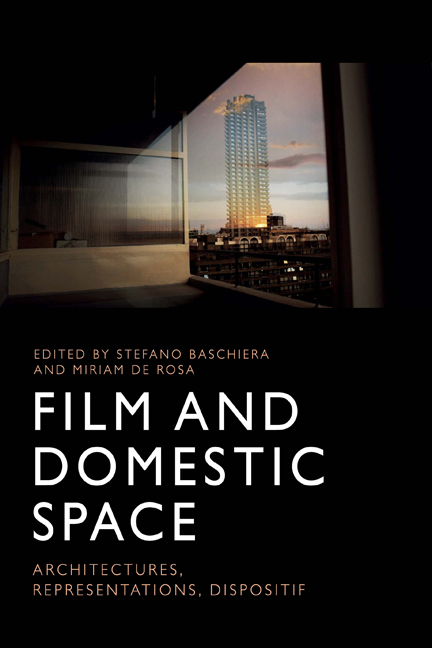Book contents
- Frontmatter
- Contents
- List of Figures
- Notes on the Contributors
- Acknowledgements
- Introduction
- 1 Architectures of Ubiquity: The Colonial Revival in Film and Television
- 2 No Down Payment: Whiteness, Japanese American Masculinity and Architectural Space in the Cinematic Suburbs
- 3 Resist, Redefine, Appropriate: Negotiating the Domestic Space in Contemporary Female Biopics
- 4 Liminal Spaces, Lesbian Desire and Veering off Course in Todd Haynes’s Carol
- 5 A Home on the Road in Claire Denis’s Vendredi soir
- 6 Acoustic Ectoplasm and the Loss of Home
- 7 Our House Now: Flat and Reversible Home Spaces in Post-war Film and Television
- 8 From Myth to Reality: Images of Domestic Space in Post-Soviet Baltic Films
- 9 No | Home | Movie: Essay Film, Architecture as Framing and the Non-house
- 10 At Home with the Nouvelle Vague: Apartment Plots and Domestic Urbanism in Godard’s Une femme est une femme and Varda’s Cléo de 5 à 7
- 11 Dwelling the Open: Amos Gitai and the Home of Cinema
- 12 What Is Cult When It’s At Home? Reframing Cult Cinema in Relation to Domestic Space
- 13 High-fructose Cinema and the Movie Industrial Complex: Radicalising the Technology of Representation in a Domestic Kind of Way
- Index
4 - Liminal Spaces, Lesbian Desire and Veering off Course in Todd Haynes’s Carol
Published online by Cambridge University Press: 22 September 2020
- Frontmatter
- Contents
- List of Figures
- Notes on the Contributors
- Acknowledgements
- Introduction
- 1 Architectures of Ubiquity: The Colonial Revival in Film and Television
- 2 No Down Payment: Whiteness, Japanese American Masculinity and Architectural Space in the Cinematic Suburbs
- 3 Resist, Redefine, Appropriate: Negotiating the Domestic Space in Contemporary Female Biopics
- 4 Liminal Spaces, Lesbian Desire and Veering off Course in Todd Haynes’s Carol
- 5 A Home on the Road in Claire Denis’s Vendredi soir
- 6 Acoustic Ectoplasm and the Loss of Home
- 7 Our House Now: Flat and Reversible Home Spaces in Post-war Film and Television
- 8 From Myth to Reality: Images of Domestic Space in Post-Soviet Baltic Films
- 9 No | Home | Movie: Essay Film, Architecture as Framing and the Non-house
- 10 At Home with the Nouvelle Vague: Apartment Plots and Domestic Urbanism in Godard’s Une femme est une femme and Varda’s Cléo de 5 à 7
- 11 Dwelling the Open: Amos Gitai and the Home of Cinema
- 12 What Is Cult When It’s At Home? Reframing Cult Cinema in Relation to Domestic Space
- 13 High-fructose Cinema and the Movie Industrial Complex: Radicalising the Technology of Representation in a Domestic Kind of Way
- Index
Summary
It is given that the straight world is already in place and that queer moments, where things are out of line, are fleeting. Our response need not be to search for permanence … but to listen to the sound of the ‘what’ that fleets. (Sara Ahmed 2006: 106)
The very frequency with which the lesbian has been ‘apparitionalized’ in the Western imagination also testifies to her peculiar cultural power. Only something very palpable – at a deeper level – has the capacity to haunt us so thoroughly. (Terry Castle 1993: 7)
For Olivia Gragnon
Introduction: ‘What a strange girl you are – flung out of space’
Set in the 1950s and based on Patricia Highsmith's novel The Price of Salt (which was originally written in 1952 under a pseudonym because of its subject matter), Todd Haynes's Carol relates the story of an illicit love affair between two women socially divided by age and class. Upon its release, critics noted the film's tasteful and chaste treatment of its literary source material; indeed, Haynes's implicit and subtle delineation of the central love story serves to ground the film in political and historical authenticity (namely, as the film makes clear, such a relationship is considered impossible, unthinkable and a moral abomination that must be impeded by law). However, this essay contends that this sublimation of lesbian desire is figured in the film not only as a trope of authenticity, but more profoundly as an affective and emotional history that plays out in liminal spaces between the social and domestic stratifications determined by patriarchal law. The radical nature of lesbian desire is adumbrated as a force that cannot exist or thrive within, and thus refuses, the hierarchical spaces of power structures (the patriarchal family home, the public space, the place of work) that are associated with masculinity in the film; yet the betwixt and between the nature of this love works fundamentally to decentre and trouble these spaces of power. In essence, I will argue that Carol traces a phenomenology of lesbianism through affective orientation towards objects and spaces that render lesbian desire as a powerful, disruptive and liminal – rather than utopian – force that refuses forms of regulation and conventional domesticity.
- Type
- Chapter
- Information
- Film and Domestic SpaceArchitectures, Representations, Dispositif, pp. 72 - 88Publisher: Edinburgh University PressPrint publication year: 2020



